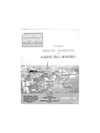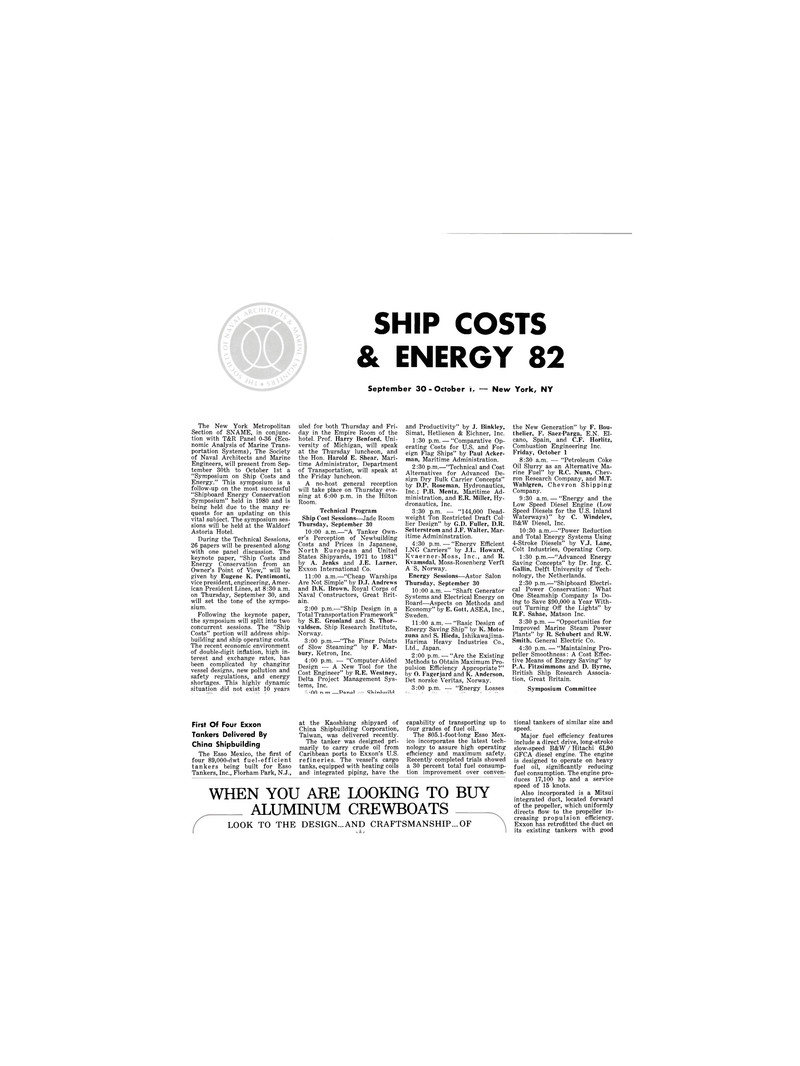
Page 4: of Maritime Reporter Magazine (September 1982)
Read this page in Pdf, Flash or Html5 edition of September 1982 Maritime Reporter Magazine
SHIP COSTS & ENERGY 82
September 30 - October — New York, NY
The New York Metropolitan
Section of SNAME, in conjunc- tion with T&R Panel 0-36 (Eco- nomic Analysis of Marine Trans- portation Systems), The Society of Naval Architects and Marine
Engineers, will present from Sep- tember 30th to October 1st a "Symposium on Ship Costs and
Energy." This symposium is a follow-up on the most successful "Shipboard Energy Conservation
Symposium" held in 1980 and is being held clue to the many re- quests for an updating on this vital subject. The symposium ses- sions will be held at the Waldorf
Astoria Hotel.
During the Technical Sessions, 26 papers will be presented along with one panel discussion. The keynote paper, "Ship Costs and
Energy Conservation from an
Owner's Point of View," will be given by Eugene K. Pentimonti, vice president, engineering, Amer- ican President Lines, at 8:30 a.m. on Thursday, September 30, and will set the tone of the sympo- sium.
Following the keynote paper, the symposium will split into two concurrent sessions. The "Ship
Costs" portion will address ship- building and ship operating costs.
The recent economic environment of double-digit inflation, high in- terest and exchange rates, has been complicated by changing vessel designs, new pollution and safety regulations, and energy shortages. This highly dynamic situation did not exist 10 years uled for both Thursday and Fri- day in the Empire Room of the hotel. Prof. Harry Benford, Uni- versity of Michigan, will speak at the Thursday luncheon, and the Hon. Harold E. Shear, Mari- time Administrator, Department of Transportation, will speak at the Friday luncheon.
A no-host general reception will take place on Thursday eve- ning at 6:00 p.m. in the Hilton
Room.
Technical Program
Ship Cost Sessions—Jade Room
Thursday, September 30 10:00 a.m.—"A Tanker Own- er's Perception of Newbuilding
Costs and Prices in Japanese,
North European and United
States Shipyards, 1971 to 1981" by A. Jenks and J.E. Larner,
Exxon International Co. 11:00 a.m.—"Cheap Warships
Are Not Simple" by D..T. Andrews and D.K. Brown, Royal Corps of
Naval Constructors, Great Brit- ain. 2:00 p.m.—"Ship Design in a
Total Transportation Framework" by S.E. Gronland and S. Thor- valdsen. Ship Research Institute,
Norway. 3:00 p.m.—"The Finer Points of Slow Steaming" by F. Mar- bury, Ketron, Inc. 4:00 p.m. — "Computer-Aided
Design — A New Tool for the
Cost Engineer" by R.E. Westney,
Delta Project Management Sys- tems, Inc. -NN RT M PANNL Chinkuil/4 and Productivity" by J. Binkley,
Simat, Hetliesen & Eichner, Inc. 1:30 p.m. — "Comparative Op- erating Costs for U.S. and For- eign Flag Ships" by Paul Acker- man, Maritime Administration. 2:30 p.m.—"Technical and Cost
Alternatives for Advanced De- sign Dry Bulk Carrier Concepts" by D.P. Roseman, Hydronautics,
Inc.; P.B. Mentz, Maritime Ad- ministration, and E.R. Miller, Hy- dronautics, Inc. 3:30 p.m. — "144,000 Dead- weight Ton Restricted Draft Col- lier Design" by G.D. Fuller, D.R.
Setterstrom and J.F. Walter, Mar- itime Admininstration. 4:30 p.m. — "Energv Efficient
LNG Carriers" by J.L. Howard,
Kvaerner-Moss, Inc., and R.
Kvamsdal, Moss-Rosenberg Verft
A S, Norway.
Energy Sessions—Astor Salon
Thursday, September 30 10 :00 a.m. — "Shaft Generator
Systems and Electrical Energy on
Board—Aspects on Methods and
Economy" by E. Gott, ASEA, Inc.,
Sweden. 11:00 a.m. — "Basic Design of
Energy Saving Ship" by K. Moto- zuna and S. Hieda, Ishikawajima-
Harima Heavy Industries Co.,
Ltd., Japan. 2:00 p.m. — "Are the Existing
Methods to Obtain Maximum Pro- pulsion Efficiency Appropriate?" by O. Fagerjard and K. Anderson,
Det norske Veritas, Norway. 3:00 p.m. — "Energy Losses the New Generation" by F. Bou- thelier, F. Saez-Parga, E.N. El- cano, Spain, and C.F. Horlitz,
Combustion Engineering Inc.
Friday, October 1 8:30 a.m. — "Petroleum Coke
Oil Slurry as an Alternative Ma- rine Fuel" by R.C. Nunn, Chev- ron Research Company, and M.T.
Wahlgren, Chevron Shipping
Company. 9:30 a.m. — "Energy and the
Low Speed Diesel Engine (Low
Speed Diesels for the U.S. Inland
Waterways)" by C. Windelev,
B&W Diesel, Inc. 10:30 a.m.—"Power Reduction and Total Energy Systems Using 4-Stroke Diesels" by V.J. Lane,
Colt Industries, Operating Corp. 1:30 p.m.—"Advanced Energy
Saving Concepts" by Dr. Ing. C.
Gallin, Delft University of Tech- nology, the Netherlands. 2:30 p.m.—"Shipboard Electri- cal Power Conservation: What
One Steamship Company Is Do- ing to Save $90,000 a Year With- out Turning Off the Lights" by
R.F. Sahae, Matson Inc. 3:30 p.m. — "Opportunities for
Improved Marine Steam Power
Plants" by R. Schubert and R.W.
Smith. General Electric Co. 4:30 p.m. — "Maintaining Pro- peller Smoothness: A Cost Effec- tive Means of Energy Saving" by
P.A. Fitzsimmons and D. Byrne,
British Ship Research Associa- tion, Great Britain.
Symposium Committee
First Of Four Exxon
Tankers Delivered By
China Shipbuilding
The Esso Mexico, the first of four 89,000-dwt fuel-efficient tankers being built for Esso
Tankers, Inc., Florham Park, N.J., at the Kaoshiung shipyard of
China Shipbuilding Corporation,
Taiwan, was delivered recently.
The tanker was designed pri- marily to carry crude oil from
Caribbean ports to Exxon's U.S. refineries. The vessel's cargo tanks, equipped with heating coils and integrated piping, have the capability of transporting up to four grades of fuel oil.
The 805.1-foot-long Esso Mex- ico incorporates the latest tech- nology to assure high operating efficiency and maximum safety.
Recently completed trials showed a 30 percent total fuel consump- tion improvement over conven- tional tankers of similar size and speed.
Major fuel efficiency features include a direct drive, long-stroke slow-speed B&W / Hitachi 6L90
GFCA diesel engine. The engine is designed to operate on heavy fuel oil, significantly reducing fuel consumption. The engine pro- duces 17,100 hp and a service speed of 15 knots.
Also incorporated is a Mitsui integrated duct, located forward of the propeller, which uniformly directs flow to the propeller in- creasing propulsion efficiency.
Exxon has retrofitted the duct on its existing tankers with good
WHEN YOU ARE LOOKING TO BUY
ALUMINUM CREWBOATS
LOOK TO THE DESIGN...AND CRAFTSMANSHIP...OF

 3
3

 5
5
